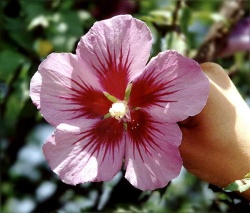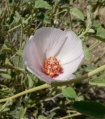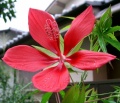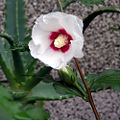Rosemallow
| Hibiscus |
|---|

|
| Scientific Classification |
|
| Species |
|
Rosemallow is the common name for the species of flowering plants belonging to the taxonomic genus Hibiscus. There are over 200 species that are mostly shrubs and small trees. In this genus. There are many different uses for these beautiful plants.
Anatomy
Hibiscus are mainly woody shrubs and small trees that are grown for their showy flowers. Their leaves are alternate, simple, and ovate to lancelet. The leaves margins are generally either toothed or lobed. The flowers have five large (4-15 cm broad), conspicuous, trumpet-shaped petals. The usual colors for these flower petals are white, pink, red, purple, and yellow.
Their fruit consists of a dry 5-lobed capsules with several seeds inside each of the lobes. These capsules split open at maturity and thus release the contained seeds.
Reproduction
Hibiscus are flowering plants and reproduce sexually. Like most flowering plants, pollination is assisted by insects such as bees or the wind.
Ecology
Hibiscus plants live in the tropics and subtropics all around the world. They are herbaceous plants that grow as either annuals or perennials in partial to the warm temperatures. There are many within Hibiscus used as State and National flowers. Below are some examples:
- Hibiscus syriacus (mugunghwa or “Rose of Sharon”) is the national flower of South Korea.
- Hibiscus rosa (Bunga Rayar or “Chinese hibiscus”) is the national flower of Malaysia.
- Hibiscus brackenridge (Ma’o Hau Hehe) is the state flower of Hawaii.
There are many uses for different parts of Hibiscus plants such as:
- Kenaf (Hibiscus cannabinus) is used in paper making.
- Roselle (Hibiscus sabdariffa) is used as a vegetable for herbal teas and jams (especially) in the Caribbean.
- Roselle is also used in the making of Jamaica drinks in Mexico as well as the petals being used in Egypt and Sudan to make a well loved tea named after the plant Karkad.
- Extracts of some Hibiscus have health benefits to prevent constipation, bladder infections, nausea, and high blood-pressure.
- Bark strips can be set in sea water (to let organic materials rot away) then be used to make grass skirts in Polynesia.
Gallery
Rose of Sharon
Hibiscus syriacus










